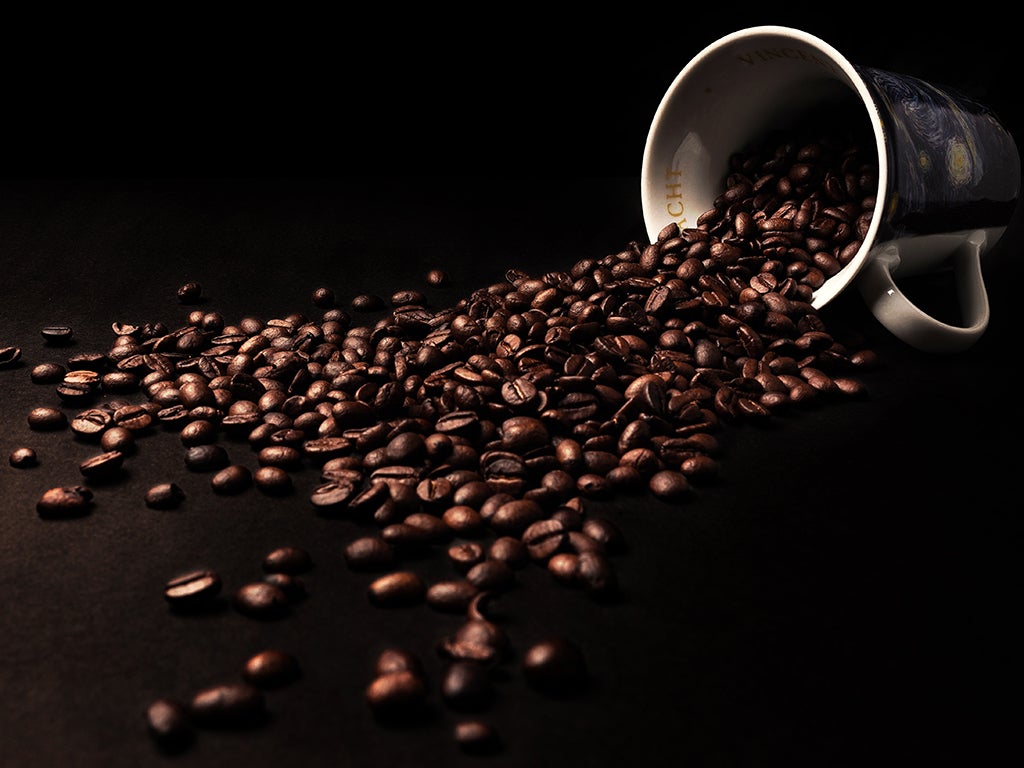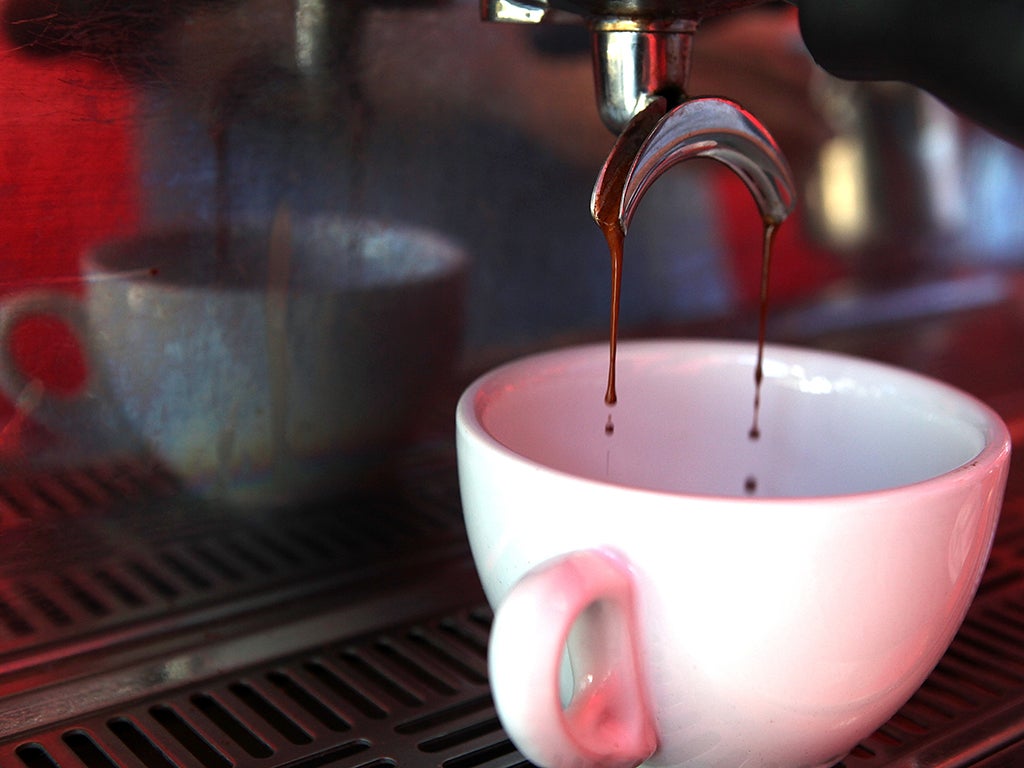Is caffeine a mug's game?
Many of us rely on coffee to wake us up, but do we drink too much? Dr Nick Knight explains the effects and limitations of caffeine

Your support helps us to tell the story
From reproductive rights to climate change to Big Tech, The Independent is on the ground when the story is developing. Whether it's investigating the financials of Elon Musk's pro-Trump PAC or producing our latest documentary, 'The A Word', which shines a light on the American women fighting for reproductive rights, we know how important it is to parse out the facts from the messaging.
At such a critical moment in US history, we need reporters on the ground. Your donation allows us to keep sending journalists to speak to both sides of the story.
The Independent is trusted by Americans across the entire political spectrum. And unlike many other quality news outlets, we choose not to lock Americans out of our reporting and analysis with paywalls. We believe quality journalism should be available to everyone, paid for by those who can afford it.
Your support makes all the difference.“I'm sittin' on the dock of the bay, Watchin' the tide roll away, ooh”. My eyes open. Then shut. Then open. The hazy outline of the rest of my pillow cuts into view, as my Otis Redding alarm unremorsefully ends my dream where I impressively calculate the restaurant bill in my head while on a date with Rachel Riley. At this moment I am a useless, organic 80 kilogram sack. How then, fast-forwarding 45 minutes, am I tip-toe-dancing over puddles in the busy streets of London, finishing the crossword of my random commuter neighbour, and mentally prioritising the day with ruthless efficiency? Caffeine, first to hit Europe around 1640, is the stimulatory saviour to many dreary, non-functioning mornings.
Whether an essential part to surviving your day, catalyst for a business meeting, or first date, you may be one of the 80 per cent of the UK adult population which find that steaming cup of coffee hitting your lips today.
Now for the science bit. Within about 45 minutes of that first sip, the caffeine from your coffee has been absorbed from your small intestines, far away from your now super-chatty mouth, and entered into your bloodstream. Now from this point, some of the caffeine is transported to your liver where it is broken down ('metabolised') into other active chemicals, while the remainder of the caffeine stays, unaltered, in your blood. Once your liver has done its work, the active chemicals, re-joins the rest of the caffeine in the bloodstream, and together they all commute to their place of work - your brain.
Now there, the key function of caffeine is to block a chemical in the brain called adenosine, which normally stimulates a specific receptor in the brain – a bit like a key fitting perfectly into a lock. The usual role of adenosine is to slow down and dampen your brain activity. Caffeine actively stops this effect for it is a similar shaped 'key' to the adenosine molecule and so can take its place on the receptor (the ‘lock’).

The result is that your adenosine cannot fulfil their normal role; instead, you get a positive build-up of energy-promoting brain processes that boost metabolism and stimulate the release of the energising hormone, adrenaline.
You stare at the bottom of the coffee mug. Empty. The caffeine, now slow-dancing with your brain cells, starts to translate into the positive effects born from caffeine within about 45 minutes of your first ingestion. You feel more alert, vigilant and attentive with the focus of a tight-rope walker over an Ayia Napa pool-party (nobody wants a mouthful of that water). The fatigue that engulfed your body is now lifting and your body and mind begin to start working in tandem with your increased mood and metabolic rate. You can expect to enjoy this for 3 to 5 hours – the half-life of caffeine.
But your cup of coffee hasn’t stopped giving yet. Not satisfied with only improving your cognitive performance, it wants to promote your physical performance too. Apart from the increase in adrenaline, the active chemical (from that earlier caffeine breakdown in the liver) called paraxantine, also helps to mobilise and break down fats by a process called lipolysis. The end result, more fat is used for energy and you spare your precious carbohydrate ‘glycogen’ reserves in your liver and muscles.

Now although helpful for enhancing your endurance performance, it may be perhaps less handy for navigating the two flights of office stairs. What may help with these stairs, however, is the fact that caffeine also reduces the perception of effort, by lowering the ‘neuronal activation threshold’, basically making it easier to recruit muscles for exercise. Before you start pouring boiling water straight into the instant-coffee jar, evidence shows very little benefit of drinking beyond 200 milligrams (mg) to boost your performance – so a mug is fine.
You glance down at the empty coffee mug again. Time for another? The guidelines for caffeine consumption are clear; although, I am aware of the fierce backlash from some coffee drinkers at my next few sentences, standing proud with cups of coffee per day that tip into double figures. The advice, however, is not to exceed 400mg of caffeine daily - about four cups of instant coffee. Pregnant women are the exception – it is half that – sorry.
Well into the day now, you realise you are once again stirring the spoon of yet another coffee. A common occurrence, like many (including myself), you end up having one too many coffees. The negative effects of caffeine excess will vary depending on amount consumed. You may start to find yourself needing to urinate more (thanks to the other caffeine breakdown product, theobromine); your heart palpitates; you develop a tremor; and if I were to take your blood pressure and heart rate, both may be markedly raised. Now if you were to really push the boat out, you may develop caffeine toxicity. This, your prize for drinking seriously excessively concentrated caffeine (500mg at once), includes symptoms of agitation, insomnia, fast breathing and cardiac abnormalities, all due in part to over-stimulation of various control centres in the brain. Over time this may also promote withdrawal.
.jpg)
Of course, caffeine comes in many guises. Apart from coffee (95mg), other common caffeine supplies passing your lips may include plain chocolate bars (up to 50mg), tea (75mg), and a regular can of cola (40mg). Then, there are those sneaky items that insidiously slip a little caffeine into your system – chocolate or coffee flavoured ice-cream (30mg per half cup), weight-loss pills and pain-killers (variable mg), and even DECAF coffee (5mg a cup)! Even so, when totalled up over a day, anecdotally it seems most of us don’t exceed 400 mg per day – so I would not worry too much. Just enjoy it.
Ah, the kettle has just boiled, so I must wrap this up. Caffeine is a mild psycho-active stimulant that is an integral part of many people’s daily grind – mine included. It is still however, a drug, and we should respect this fact; for beyond the positive cognitive and physical effects with healthy, moderated consumption - excess can be dangerous. As always – if you have concerns about your caffeine drinking then do have a chat to your GP. Now, where is the milk…
Dr Nick Knight is a junior doctor based in London with a PhD background in human performance. His blog on life as a doctor can be read at: https://drnickknight.wordpress.com/
Or follow him via Twitter: @Dr_NickKnight
Join our commenting forum
Join thought-provoking conversations, follow other Independent readers and see their replies
Comments